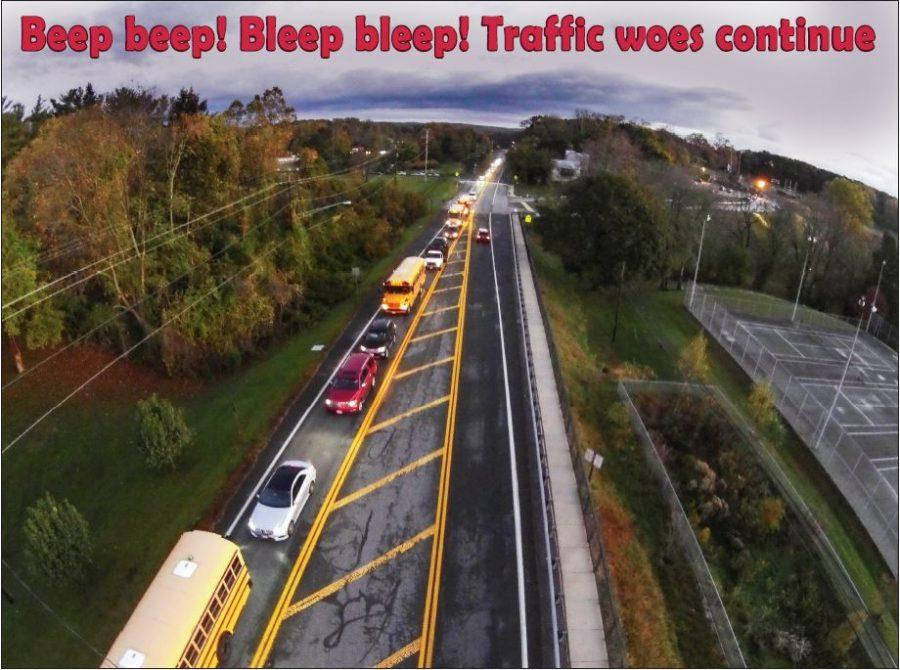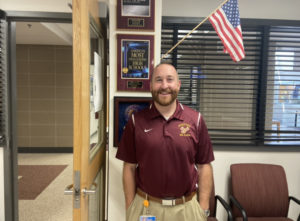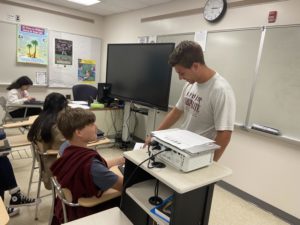Morning traffic frustrates late students
Cars line up on York Road on a typical Thursday morning, causing delays. “With traffic I’ll get to school around 7:25, without traffic I can get to school at 7:10,” Pete Wickiser (‘17) said.
November 14, 2016
Traffic is affecting students and staff alike. In the morning, York Road can be very congested coming from north of the high school, and it’s not uncommon for it to be backed up all the way to Hillbilly Beach. For students, this poses a serious problem.
“It makes me really late, and I usually have to get late passes in order to come into school,” Pete Wickiser (’17) said. “I don’t want an after-school detention, so it’s really stressing me out in the morning. I can’t get my coffee, my bagel, I just gotta go.”
For English Teacher Michelle Vance, the traffic can add serious time to her commute. “It takes me about 9-11 minutes to get here. Sometimes it takes me 30 minutes just to get up the hill [from Hillbilly Beach],” Vance said.
It adds significant time to students’ commutes as well. “[I leave at] 6:45 to 6:50, and with no traffic it takes 12 minutes. Today it took 25,” Hannah Weeren (’18) said.
Behavioral Interventionist John Spencer, who records morning lateness, has noticed the trend between lateness and traffic. “I get quite a few [latenesses] if we get a back-up on the road,” Spencer said. “If they thought they were gonna get here on time and that backs them up anywhere from five, ten, [to] twenty minutes, it’s at least ten more kids [late].”
Sometimes the administration decides to hold attendance, but that is only in extreme conditions. The decision to hold attendance is largely based on bus arrivals. Spencer said, “We understand if it’s a giant mess, but if all the buses are in on time, then it’s pretty much saying you should’ve gotten here on time. That’s the big indicator.”
As convenient as it would be to blame the administration, the traffic is often a result of bad road conditions, or just bad luck.
“On an ideal day, there is very little to any traffic – it’s a steady flow. It’s when there’s darkness, fog, foul weather, or there’s an accident that it creates that congestion,” Assistant Principal John Billingslea said. “There are so many different factors.”
However, traffic this year seems to have taken a turn for the worst. “We’ve had a dozen accidents this year on 83 or surrounding roads, so that increases the number of cars that would normally be taking 83 onto York Road. It multiples a problem [and has] caused a back-up I’ve not seen before,” Billingslea said.
Though it may seem that there’s nothing you could do to help, a recent article published by The Wall Street Journal explains that one driver can prevent a traffic jam. By simply maintaining a constant speed and leaving a larger gap between your vehicle and the vehicle in front of you, you can help avoid back-up. “The tailgating philosophy [is that] you push ahead, and you think if everybody would just push ahead, then everyone would go faster,” Seattle engineer William Beaty said in the article. However, “it just turns the road into a parking lot.”
More concrete potential fixes include widening the entrance to the high school, making it a dual-lane, or modifying the exit light to flash yellow, which would act as a stop sign.
“I think that [exit] light should be blinking,” Vance, said. Though that’s not her only idea. “Or all Pennsylvania people should be charged a 20 dollar fine…They are the devil…it makes me want to scream you stupid Pennsylvanians.”
For the time being, however, this traffic seems to be something drivers may just have to come to terms with, and stay positive about. “We discount the number of days there is normal flow, but if you have one or two days a week that have a significant pile-up, it feels like it it’s always piled up,” Billingslea said.
Caption: Cars line up on York Road on a typical Thursday morning, causing huge delays. “With traffic I’ll get to school around 7:25, without traffic I can get to school at 7:10,” Pete Wickiser (‘17) said.







